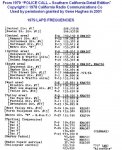Thank you for that further information KMA367. I have a couple more questions that I hope you can answer if you don't mind.
How does the communications system work?
For example, Channel 12 (77th Street) is a dispatch frequency. Are units able to talk to each other or are they only capable of talking to the base for handling incidents?
Lets say 12A34 wants to talk to 12L16 at the scene of a call or en-route to a call. Would they move to a talk-around channel so they can talk to each other, such as Channel 112. I would imagine this is the case so it doesn't tie up the dispatch channel.
Yes, that's exactly how it's
supposed to work, and how it's usually done, precisely for the reason you suggest. However - and this seems to be happening more and more the last few years - during particularly hot incidents like "officer needs help" calls and foot pursuits the officers involved have enough going on without having to stop and mess with their radios. The dispatcher (RTO) may put the dispatch frequency on a "stand-by," either on her/his own accord, or upon the request of a unit or supervisor. If it becomes a drawn-out affair, like setting up a perimeter, it will be moved to either the division "simplex" frequency, or else to an available bureau or citywide tac frequency.
Basically, what I am getting to here is, what would the difference be between Dispatch Channels and Talkaround Channels communications-wise? I understand the difference between the two, but how does this configuration work in LA? This question further relates to their present configuration as well.
The so-called (and mis-named) Division "simplex" tactical frequencies, and the Bureau and Citywide Tac frequencies are all user-selectable for either simplex (direct) or duplex (repeater) mode. The divisional tac freqs, Channels 101 to 125, each have their repeaters within their division, most or all of them at the station, so their range is good, but it's more limited than the bureau and citywide tacs, whose repeaters are on mountaintops and a couple tall buildings. In addition, the seven citywide tacs use synchronized simulcast, and transmit from multiple sites simultaneously for even better range and coverage.
The dispatch frequencies are duplex only, and this goes back to the change from analog to digital. When they were analog, each division's "tactical" frequency was its dispatch frequency but used in true simplex (direct) mode on the talk-out side. As long as the officers were close enough to each other they could communicate, and usually could hear (but not be drowned out by) the dispatcher. So it was sort of a double benefit: they could talk car-to-car, but still have half an ear listening to dispatch in case a good call, or a message for them, came out. And "switch to simplex" became so entrenched in everyone's vocabulary that when the change I'll describe next occurred, it remained and "simplex" is still the word used today when officers want to talk on their division tac frequency
As you may know about digital, the signal is usually all or nothing. When they first went to digital the channels remained configured as before. However, all of a sudden they found that simplex was fine until their (or any) dispatcher would transmit a call on their frequency. The competing simplex and dispatch signals would essentially cancel each other out and they would hear either complete gobbledygook, or more likely, nothing at all. To my knowledge nobody has ever explained or fessed up to why this "feature" of digital either wasn't made known or provided for before they made the change. So between 2001 and the radio reconfiguration in 2004, there were no division tacs available. The Saber IIIs did however, have a number of unused frequency pairs that were later (2004) to become dispatch frequencies, so each bureau got a couple of them to use as tactical freqs in the meantime.
Clear as mud now?



